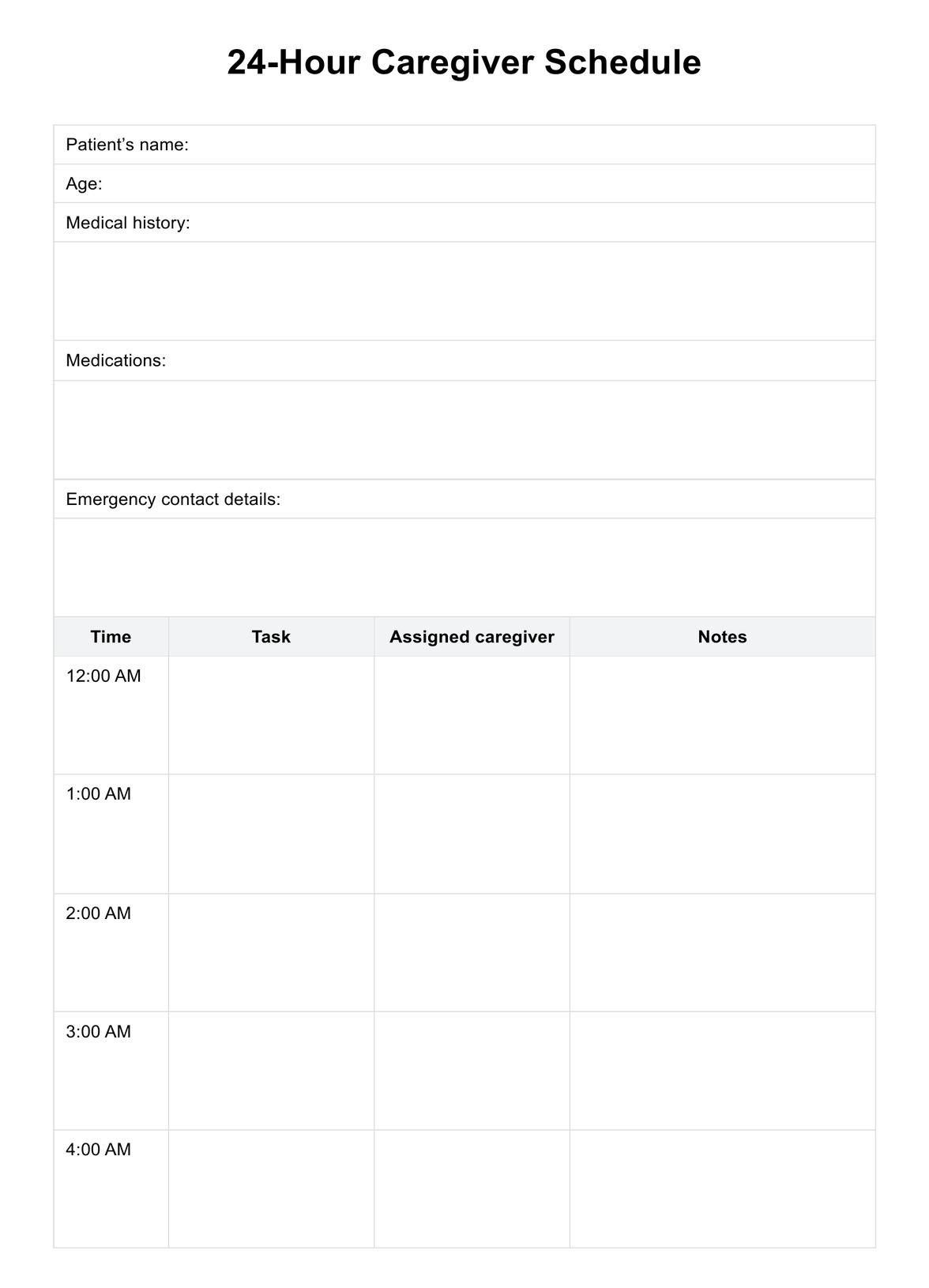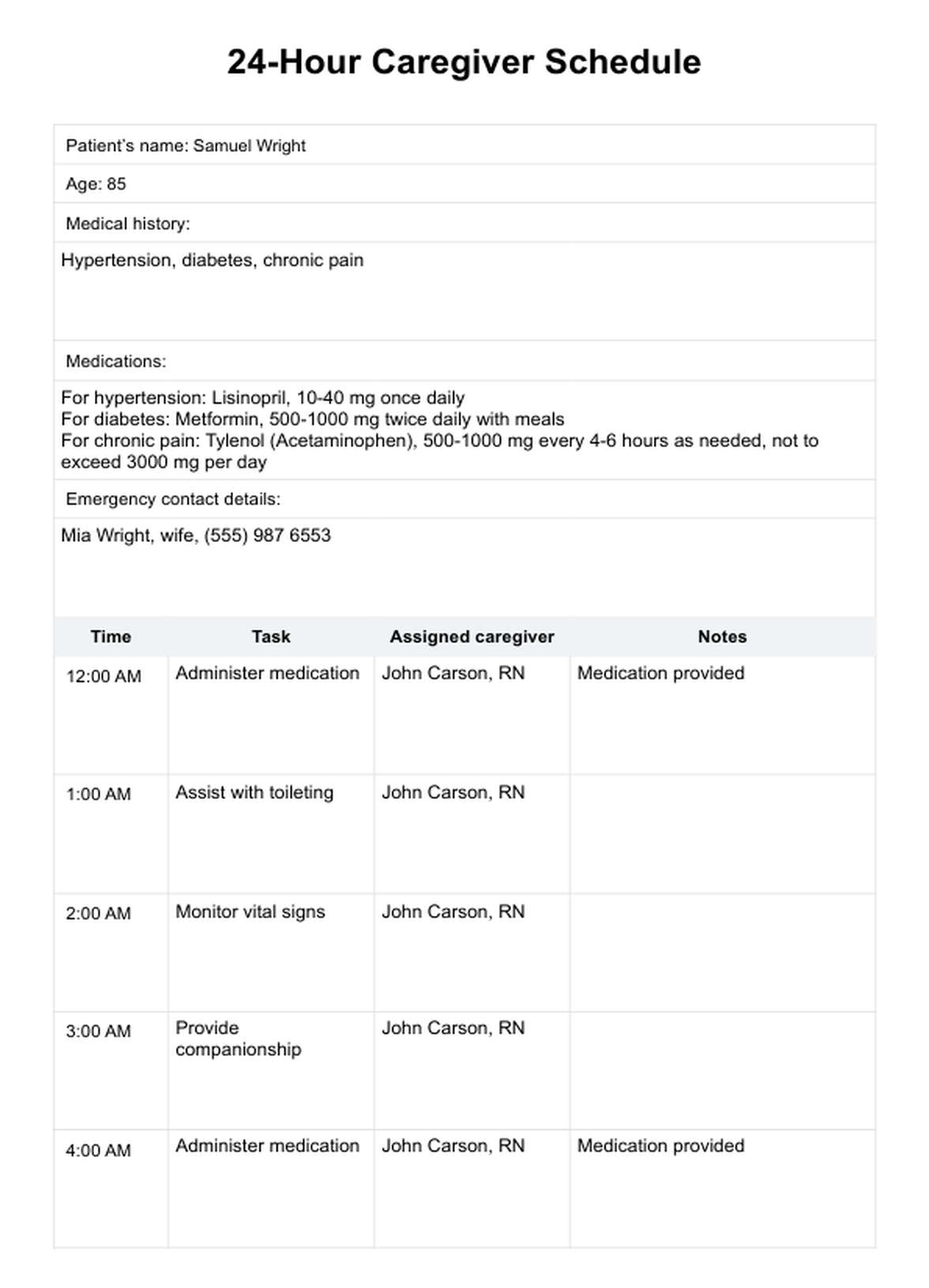24-hour Caregiver Schedule Template
Download Carfepatron's free PDF template and example for a 24-hour caregiver schedule. Stay organized and ensure proper care.


What is a 24-hour caregiver schedule?
A 24-hour caregiver schedule is a comprehensive plan that outlines the tasks and responsibilities involved in providing round-the-clock care to individuals in need. It's a structured framework designed to help family members or professional caregivers manage the daily schedule associated with caregiving effectively.
This caregiver schedule typically refers to a caregiving arrangement where one or more caregivers provide around-the-clock care and assistance to an individual in need. This could be an elderly person, someone with a disability, or someone recovering from an illness or surgery. The schedule is divided into shifts, usually 8 to 12 hours each, to ensure continuous daily and night care. This type of schedule is common for individuals who require constant supervision, medical assistance, or help with daily activities such as bathing, dressing, feeding, and mobility.
In essence, this schedule serves as a roadmap for caregivers, detailing all the tasks that must be accomplished throughout the day to ensure the well-being and comfort of the individual under their care. From assisting with daily activities such as bathing, dressing, and meal preparation to managing medications and providing emotional support, a 24-hour caregiver schedule covers all aspects of caregiving.
How long is each shift for each caregiver?
Each caregiver shift in a 24-hour caregiving setup typically varies in duration. Shift lengths can range from 8 to 12 hours, depending on the specific arrangement and the needs of the individual requiring care. Some caregivers may opt for shorter shifts to maintain a healthy work-life balance, while others may prefer longer shifts to minimize transitions and provide continuity of care.
Ultimately, the length of each shift is determined by factors such as caregiver availability, the complexity of the individual's needs, and organizational preferences within the caregiving team.
What does a shift entail for each caregiver?
During each shift, caregivers are responsible for a variety of daily tasks and duties to ensure the well-being and comfort of the individual under their care. Here's a breakdown of what a shift typically entails for each caregiver:
- Assisting with activities of daily living (ADLs) such as bathing, dressing, grooming, and toileting.
- Administering medications according to prescribed schedules and dosage instructions.
- Monitoring vital signs and observing any changes in the individual's health or behavior.
- Preparing and serving meals, taking into account any dietary restrictions or preferences.
- Providing companionship and emotional support through engaging conversation and activities.
- Performing light housekeeping tasks such as tidying up living spaces and doing laundry.
- Assisting with mobility and transfers, using proper lifting and transfer techniques as needed.
- Communicating with family members and healthcare professionals to provide updates on the individual's condition and progress.
Each caregiver shift is a dedicated period during which these tasks are carried out with care and attention to detail, ensuring the individual's needs are met effectively.
24-hour Caregiver Schedule Template
24-hour Caregiver Schedule Template Example
What is a 24-hour Caregiver Schedule Template?
A 24-hour Caregiver Schedule Template is a pre-designed document that outlines the tasks, responsibilities, and time slots for caregivers providing round-the-clock care to individuals in need. These templates serve as a structured framework to help caregivers stay organized and manage their tasks effectively throughout the day.
Caregiver schedule templates typically include designated sections for each hour of the day, allowing caregivers to fill in specific hours, tasks and activities according to the individual's needs. This level of organization helps caregivers track their daily activities and determine when to rest or attend to personal matters while ensuring continuous care for the individual.
Moreover, these templates often provide space to note any concerns, health issues, or special instructions related to the individual's care. They may also include contact information for healthcare providers, emergency services, or other relevant parties, enabling caregivers to access assistance or additional services.
How is it structured?
A 24-hour Caregiver Schedule Template is structured clearly and organized to facilitate effective caregiving. Here's how the template is typically structured:
- Hourly breakdown: The template is divided into hourly time slots covering the entire 24-hour period, allowing caregivers to schedule tasks and activities day and night.
- Task categories: Tasks are categorized based on their nature and frequency, such as medication administration, personal care, meal preparation, and companionship.
- Space for notes: The template includes designated sections or note columns where caregivers can jot down important information, such as specific care instructions, health concerns, or upcoming appointments.
- Contact information: A section may list contact details for healthcare providers, family members, emergency services, and other relevant contacts for easy reference.
- Personalization options: Some templates offer flexibility for personalization, allowing caregivers to customize the schedule to suit the individual's unique needs and preferences.
How to use our 24-hour Caregiver Schedule Template
Carepatron's 24-hour Caregiver Schedule Template is designed to streamline the caregiving process and ensure that all tasks are efficiently managed. Medical practitioners can follow these steps to utilize the template effectively:
Step 1: Accessing the template
Log in to your Carepatron account. Go to our Resource Library to find the 24-hour Caregiver Schedule Template.
Step 2: Adding tasks and responsibilities
Fill in each time slot with the tasks and responsibilities that must be completed during the designated hours. Include details such as medication administration times, meal schedules, personal care routines, and other pertinent information.
Step 4: Assigning caregivers
Assign specific caregivers to each task or time slot, ensuring clarity and accountability in the caregiving process. Consider caregiver availability, expertise, and rapport with the individual when making assignments.
Step 5: Reviewing and sharing
Review the completed schedule to ensure accuracy and comprehensiveness. Share the schedule with relevant stakeholders, including other caregivers, family members, and healthcare professionals, to keep everyone informed and coordinated.
Step 6: Updating and adjusting as needed
Review and update the schedule regularly to accommodate changes in the individual's condition, caregiver availability, or care plan. Make adjustments to ensure the caregiving process remains efficient and effective.
What happens if the schedule isn't followed?
Deviation from the established 24-hour caregiver schedule can lead to various consequences that may impact the caregiver and the individual receiving care. Failure to follow the schedule may result in missed medication doses, incomplete personal care tasks, or disruptions in meal timings, compromising the individual's health and well-being.
Additionally, a lack of adherence to the schedule can lead to disorganization and inefficiency in caregiving, potentially causing stress and frustration for both the caregiver and the patient. Moreover, it may hinder the ability to track and address health concerns effectively, leading to potential complications or deterioration in the patient's condition.
Adherence to the schedule is crucial to ensuring continuity of care, promoting optimal health outcomes, and providing a high level of service to the patient.
How often should this schedule be updated?
The 24-hour caregiver schedule should be updated regularly to reflect changes in the individual's condition, care plan, or availability. As a general guideline, reviewing and updating the schedule at least once a week or more frequently, if necessary, is recommended. This ensures that the schedule remains current and aligned with the individual's evolving needs, allowing caregivers to provide the highest quality of care.
Additionally, prompt updates enable caregivers to stay organized, track changes in medications or treatments, and effectively address any emerging health concerns.
Commonly asked questions
A live-in caregiver resides with the individual requiring care and provides assistance as needed throughout the day and night. In contrast, a 24-hour caregiver may work in shifts, with multiple caregivers providing continuous care round the clock.
A caregiving routine is a structured schedule that outlines the tasks and responsibilities caregivers perform daily to support the individual's needs, including personal care, medication management, and household chores.
To make time for yourself as a caregiver, prioritize self-care activities such as exercise, relaxation, and socialization during periods when the individual is resting or receiving assistance from another caregiver or family member.







































































































